How Much Exercise Per Week to Build Muscle
How often should you work out? That might look like a single question, but there are actually two questions in there:
- How often should you train each muscle?
- How many times per week should you work out?
For example, if you do 3 full-body workouts per week, you'd be training your muscles three times per week. But if you do a 5-day split routine, dividing your body up into 5 different areas, you'd be training each muscle just once per week. So it's possible to work out more often while training your muscle less often, or vice versa.
So first we need to see how often you should train each muscle. Then we can talk about the best way to schedule your workout routine so that you're training each muscle hard enough, often enough.
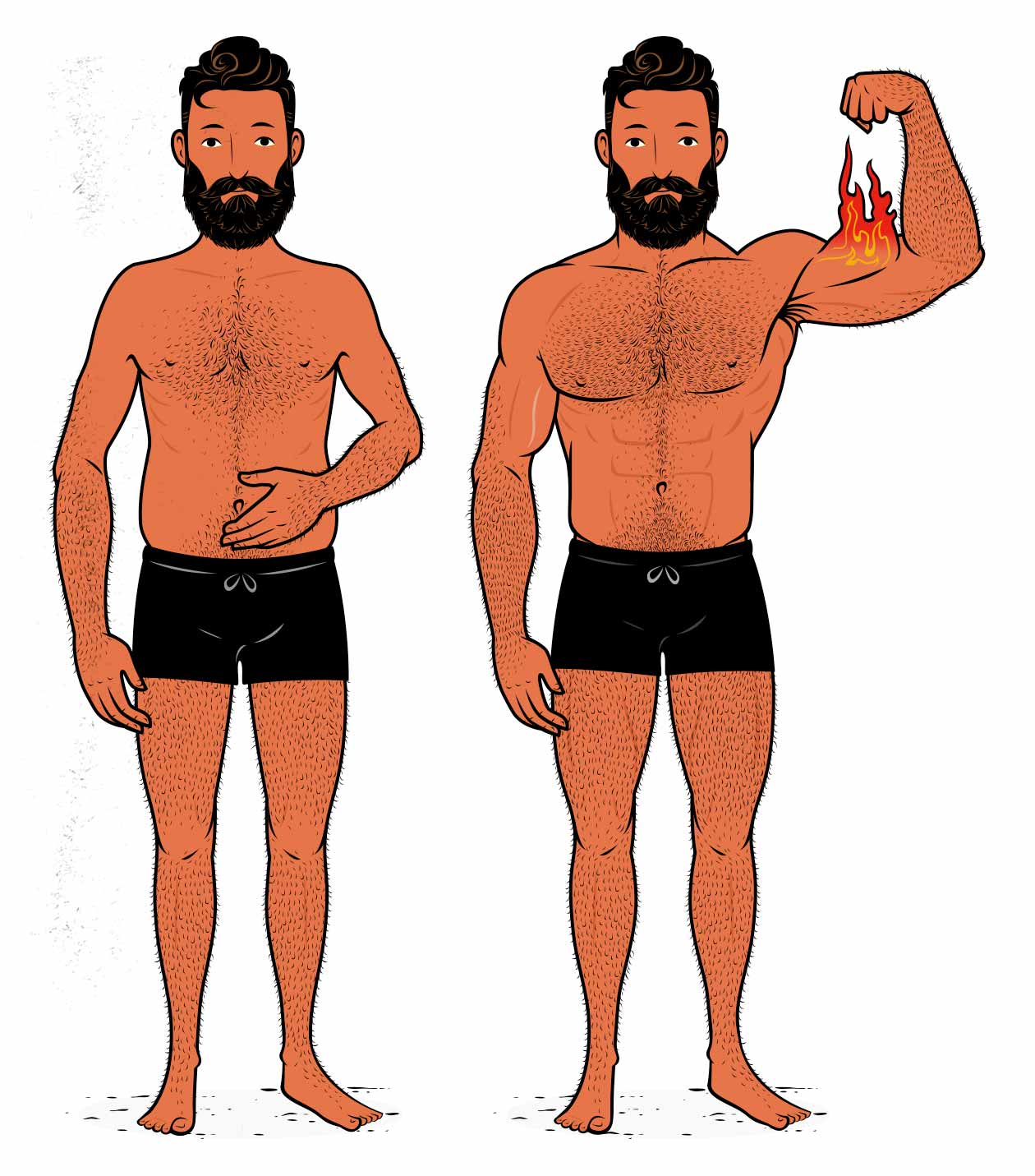
How Often Should You Train Your Muscles?
How Long Do You Build Muscle After Weight Training?
If you're trying to build muscle as fast as possible, you want to keep your muscles growing all week long. So to figure out how often you should train your muscles, we can look at how long you build muscle after working out.
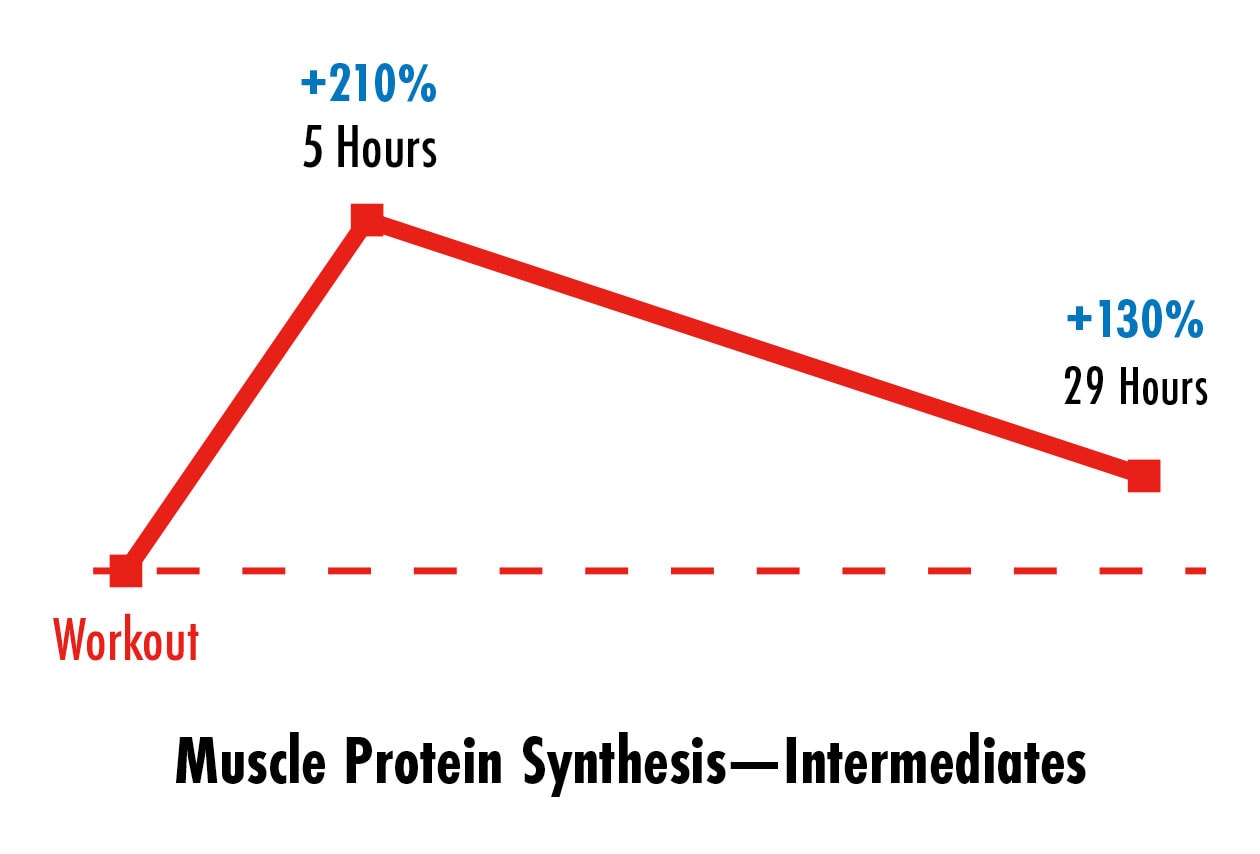
If we look at a study done on intermediate lifters, we see that doing a single exercise for 3 sets stimulates over a day of muscle growth. If we look at another study, we see that doing an exercise for 6 sets stimulates over two days of muscle growth. In a third study, working out stimulated over three days of muscle growth. This tells us that a good workout will keep us growing for a good 2–3 days.
Then, if we look at a systematic review comparing beginners and intermediate lifters, we see that working out stimulates muscle growth for about the same amount of time, it's just that beginners see a faster rate of muscle growth. This idea that intermediate lifters need to train more often because they're more advanced is a bit of a myth, and in some cases, the opposite is true. There are cases where intermediate lifters benefit from training less often, which we'll discuss deeper in the article.
Note: just to clear up any potential confusion, we're talking specifically about muscle growth, so we're talking specifically about myofibrillar protein synthesis—building muscle fibres. That can get confusing because some research, such as this study, shows that mixed muscle-protein synthesis abates after about 24 hours in intermediate lifters. Studies like that are often used to show that our workouts only stimulate a single day of growth. But if we look at what's going on in the muscle fibres, we see that growth is still taking place for 2–3 days after working out.
A challenging workout stimulates at least 2–3 days of muscle growth. That means that to keep our muscles growing all week long, we should be training them at least twice per week.
Recovery & The Repeated Bout Effect
We need to consider how long it takes our entire bodies to recover from our workouts, and that doesn't always line up with how long it takes our muscles to recover. Maybe a workout stimulates 2–3 days of muscle growth, but it takes us 4–5 days to recover from the fatigue or soreness of the workout.
Most research isn't very good at measuring recovery. See, what researchers do is they take a group of participants, put them on a standardized workout routine, and then monitor what happens. Thing is, if we take someone, give them a new workout routine, and then measure the muscle damage it causes, we see a massive amount of disruption. That's because the stimulus is new, unfamiliar. We haven't adapted to it yet. We're still vulnerable to it.
People who aren't in the habit of lifting weights are especially vulnerable, and can get sore for a full week after lifting weights. Even with habituatl lifters, when they start a new training routine, it can cause quite a lot of muscle damage. So if researchers use participants who aren't already doing a similar routine to the one being tested, the amount of muscle damage they see can be exaggerated.
That's where the repeated bout effect comes in. Over time, as we acclimatize to our training, we grow tougher, our workouts cause less muscle damage, and we start being able to recover much more quickly, allowing us to train more often. For example, in this study, it took people four days to recover from their first workout, but only a single day to recover from their second workout.
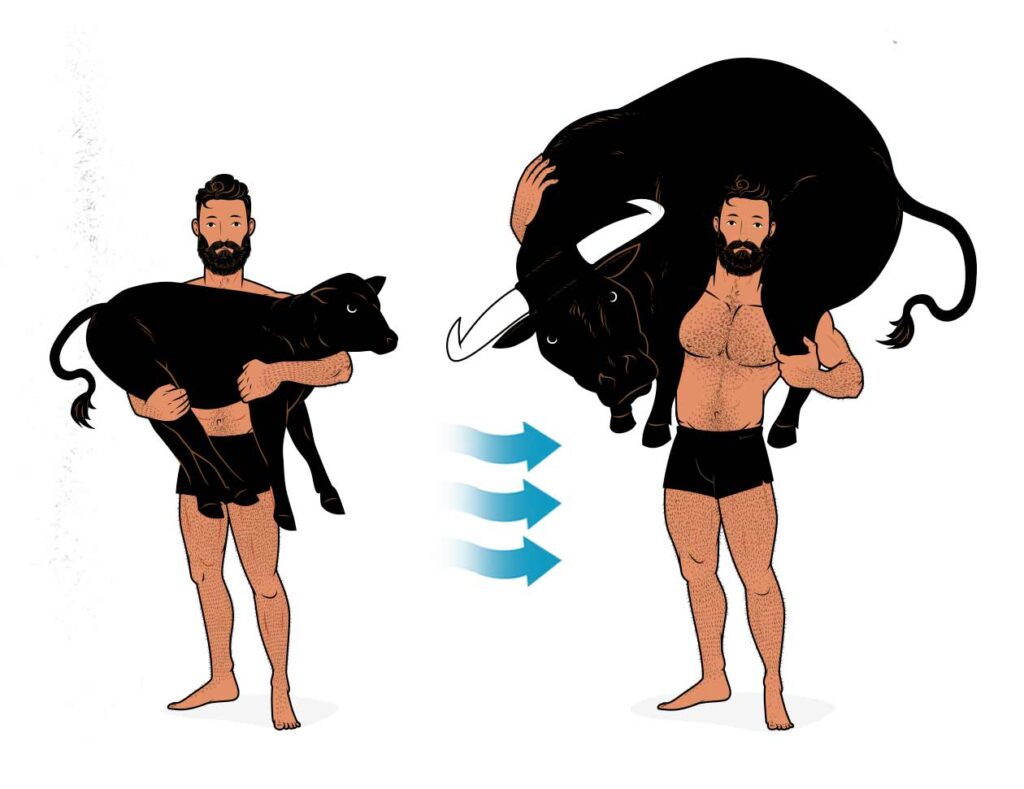
For another example, in this study, doing just 3 sets per exercise caused 3 days of muscle damage, preventing the participants from lifting more weight two days later, during their next workout. In this case, it would have been better to start with 2 sets per exercise or to wait 3 days between workouts.
For instance, in the very first week of your workout program, perhaps you do 2 sets per exercise and stop at least 2 reps shy of failure. That way you don't overdo the muscle damage. The next week, add a third set and inch a bit closer to failure on that third set, ensuring that you're still providing a good stimulus. The week after that, add another set, and push yourself even harder. After a few weeks, adjust your exercise routine a little bit, and begin a new phase.
Okay, with that in mind, let's look at how different training frequencies affect muscle growth over time.
Training Your Muscles Once Per Week
Okay, so we know that working out stimulates muscle growth for 2–3 days, but that doesn't necessarily tell us how often we should be working out. To know for sure, we should look at how much actual, bonafide muscle growth people get from different training frequencies.
A recent study by Schoenfeld did just that. He had one group training their muscles once per week using a push/pull/legs split, and the other half training their muscles 3 times per week using full-body workouts. Both groups did 3 workouts per week, and both did the same number of exercises and sets, giving them the same overall training volume. The only difference was how often they were training their muscles.
All of the muscles we investigated showed greater growth from a higher training frequency.
Brad Schoenfeld, PhD
The group doing full-body workouts saw greater muscle growth in every area that reached statistical significance (such as biceps growth). In fact, even in the metrics thatdidn'treach statistical significance, such as strength gains and overall muscle growth, the full-body groupstill did better.
Training your muscles once per week is enough to stimulate muscle growth, but we can build muscle even faster by training our muscles at least twice per week.
Training Your Muscles 2–4 Times Per Week
After the Schoenfeld study, a new wave of research surged in. All of the studies came to the same conclusion: doing just a few sets per muscle group is enough to stimulate muscle growth, but we should be training our muscles every 2–4 days (meta-analysis).

In fact, every single study found a benefit to training our muscles at least 2–4 times per week. The effect was quite large, too, showing 48% faster muscle growth.
It seems that this extra muscle growth can be explained by two things:
- Frequency: if we train our muscles every 2–4 days, then we can keep our muscles growing all week long, and so we can build muscle faster.
- Pacing: if we spread each muscle's work out over multiple workouts, fatigue is less of an issue, allowing us to lift more weight and eke out more reps, stimulating more muscle growth.
Training our muscles once per week isn't enough to maximize our rate of muscle growth. If we train our muscles 2–4 times per week instead, we can build muscle around 48% faster.
Training Your Muscles Every Day
So, we know that workout out our muscles 2–4 times per week builds more muscle than working them out just once per week. Great. But what about if we train our muscles every day? Would that help us build muscle even faster?
That's where high-frequency training comes in. High-frequency training is based on the idea that you can build muscle even faster by training your muscles 4–6 times per week. That means doing shorter, easier workouts. Instead of doing 3–8 sets per muscle group per workout, you might only do 1–3 sets. And instead of lifting close to failure, you might stop a good few reps shy. That way you aren't causing as much muscle damage each workout, allowing you to work out more often.
Even so, there are some things to watch out for. Just because our target muscles are recovering, that doesn't mean our tendons and joints are. And what about the muscle we use every workout, like those in our hands, forearms, upper traps, and spine? That's why the hypertrophy researcher James Krieger, MS, notes that high-frequency training can cause wear and tear on our joints. That's why he had to stop his experiment of working out every day, reverting back to a more conventional approach. He also noted that working out every day wasn't giving him faster muscle growth or strength gains. The only noticeable difference was more joint pain.
Plus, there doesn't seem to be a benefit to training your muscles every day. If you work your muscles hard enough, you can stimulate 2–4 days of muscle growth with a single workout, and so there's little benefit to training more often than that. It could be that some people benefit from working out more frequently, and some people certainly prefer it, but for the majority of people, it doesn't seem to help. We're already gaining muscle at full speed.
To be fair, there's some research showing that high-frequency training can help us build muscle faster. The problem is, that research compares training our muscles every day against training them just once per week. If we look at studies, like this one and this one, comparing training our muscles 3 times per week against training our muscles 6 times per week, the advantage to training more often disappears completely. Both groups gained the same amount of muscle mass and strength. The same is true when we compare 5-day full-body routines against 5-day split routines. Both produce the same amount of muscle growth (study).
High-frequency training is a new style of training without much research looking into it. At the moment, there's no evidence that training a muscle every day causes more muscle growth than training it twice per week.
How Often Should You Train Different Muscles?
Alright, so, we've covered why training our muscles 2–4 times per week is ideal for building muscle. But that's a range. Should you work out your muscles 2, 3, or 4 times per week? It depends on a few different different factors, and one of those factors is which muscle group we're talking about.
Now, before we dive into the details, it's worth pointing out that everyone is a little bit different, and as you grow stronger and tougher, you'll probably notice some changes.
A beginner is sensitive to the muscle damage caused by working out, and so working out more frequently can be hard. But after they get used to training, they're often able to train quite frequently, given that their muscles aren't very big yet, and they aren't strong enough to cause much overall disruption. At this point, training your muscles 3–4 times per week can work great, and full-body workouts are a great way to do that.
As you build ever more muscle, you'll learn how to push yourself harder, your bigger muscles will sustain more overall damage, and your tendons and bones will be under more pressure. You may find that after a few heavy sets on the squat or bench press, you're wrecked for a few days. And not just in your target muscles, but in your stabilizer muscles as well, such as the spinal erectors in your lower back. At that point, training your muscles just twice per week starts to make more sense. This is where splits can come in.
As a general rule of thumb, you should do enough reps to get a pump, do enough sets to fatigue your muscles, and work your muscles hard enough to cause at least some soreness. Then, when that soreness abates, you're ready to train those muscles again.
How Often Should You Train Your Chest?
Your chest is one of your bigger and stronger muscle groups, and it's possible to train your chest quite hard, stimulating a ton of muscle growth, and also causing quite a lot of muscle damage. Once you're good at the bench press, training your chest twice per week is often enough.
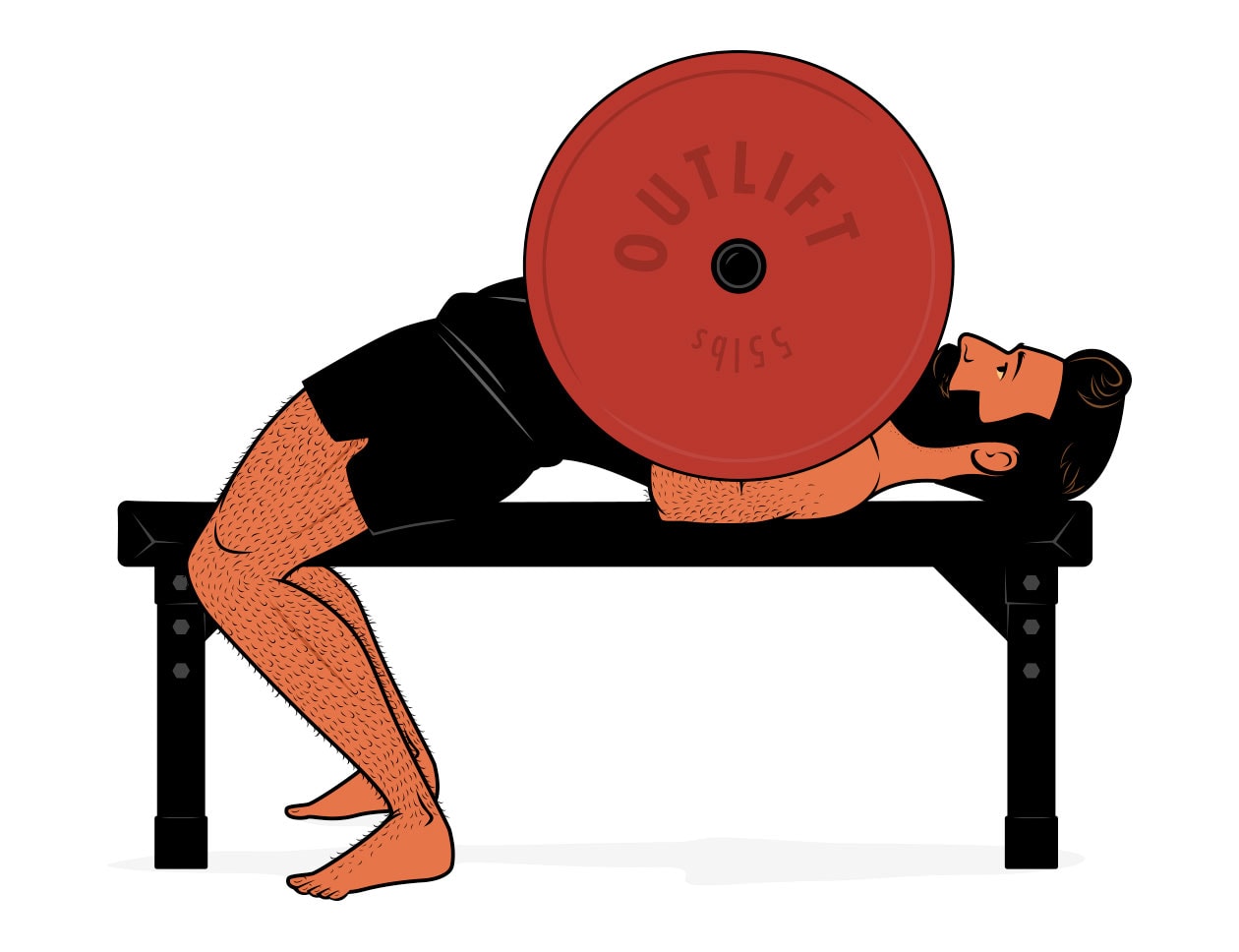
If we look at the bench press, it's a lift that challenges your chest in a deep stretch, stimulating a ton of muscle growth and also causing quite a lot of disruption. For example, this study found that it took 4 days to fully recover from doing 8 sets of the bench press. To be fair, 8 sets of the bench press is quite a lot, and in this study, where the participants did just 3 sets of 10 repetitions on the bench press, it only took 2–3 days for their chests to recover. So if you do fewer sets, you can train your chest more often. And if you do more sets, you might need longer to recover. Both approaches seem to produce a comparable amount of muscle growth. It's up to you.
There are a variety of different ways to train your chest, and a variety of different rep ranges you can use. To stimulate a maximal amount of muscle growth, you'll probably want to focus on lifts that challenge your chest in a deep stretch, such as the barbell bench press, dumbbell bench press, close-grip bench press, deficit push-up, and dumbbell fly. Doing 6–20 reps per set will stimulate the most muscle growth, and doing 3–8 sets per workout tends to be ideal.
How Often Should You Train Your Back?
Most people can get away with working out their backs quite frequently, training it 3–4 times per week without running into any issues. And that's good because our backs are involved in almost every lift we do!
When we squat and deadlift, our spinal erectors need to stabilize our spines. When we hold weights in our hands, our upper traps engage. And our biceps are often active, both in the gym and in our day-to-day lives. Our backs get a lot of work, and they tend to handle it well.
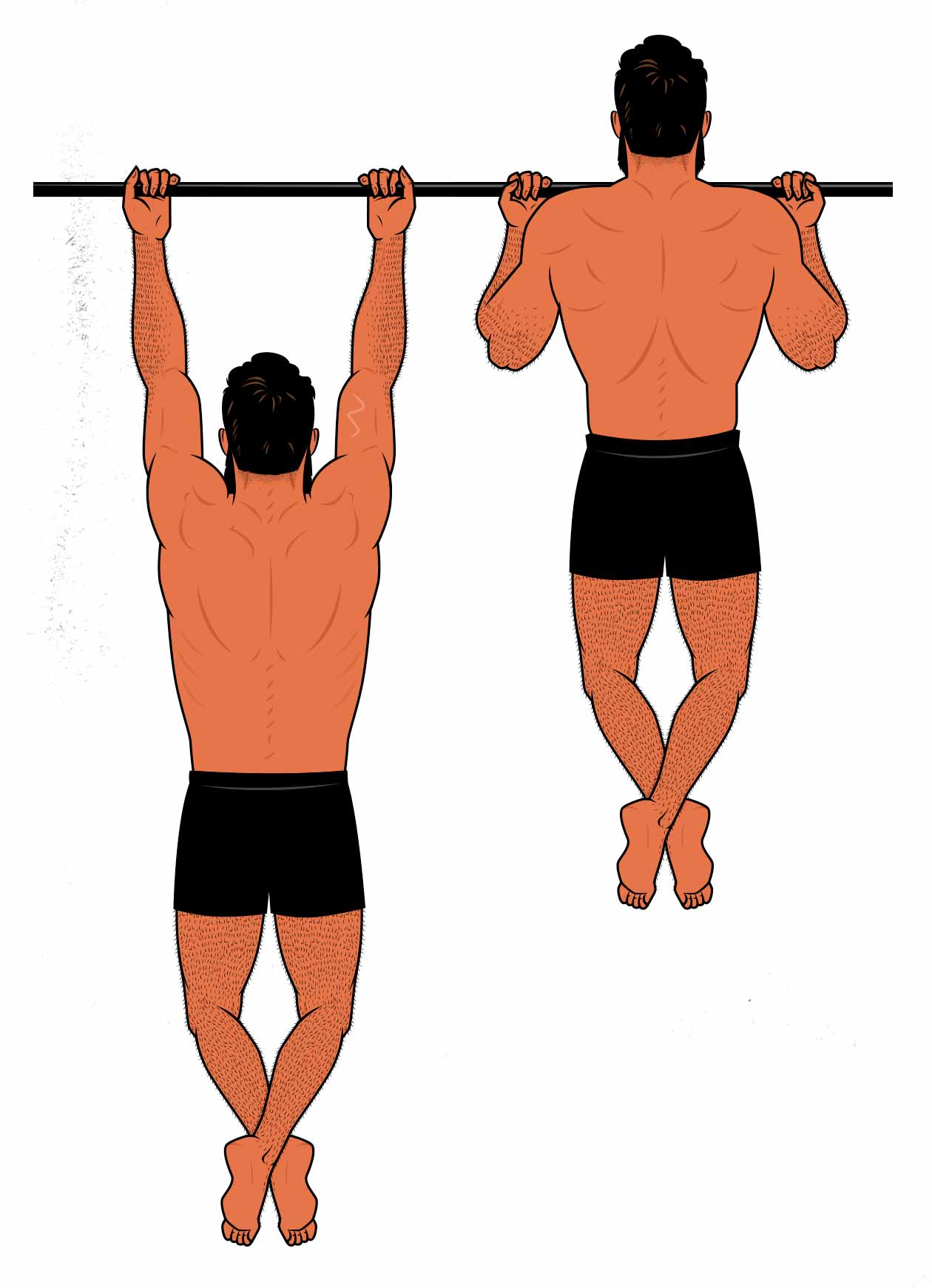
With lifts that don't work our spinal erectors, such as the chin-up, pull-up, lat pulldown, and t-bar row, you can probably benefit from training them at least 3 times per week without much risk of it interfering with your other lifts.
With the lifts that hit your spinal erectors hard, such as barbell rows and deadlifts, you might want to be more conservative, doing them just once a week, especially if they leave your back feeling sore for several days. That way, you aren't being limited by your back strength when doing squats, curls, and so on.
How Often Should You Train Your Legs?
The muscles in our legs are the biggest muscles in our bodies, and so they can often get quite sore for quite a long time. It's common for people to only train their legs twice per week, especially if they're strong, and especially if those workouts are challenging.
Our quads and glutes are the two biggest muscles in our bodies, and like our chests, it's possible to challenge them in a deep stretch, stimulating a ton of muscle growth and causing quite a lot of disruption. For example, in this study, it took 4 days to fully recover from doing 5 sets of 12 repetitions on the leg press. As a result, you may only want to train your legs 2–3 times per week, especially as you get stronger.
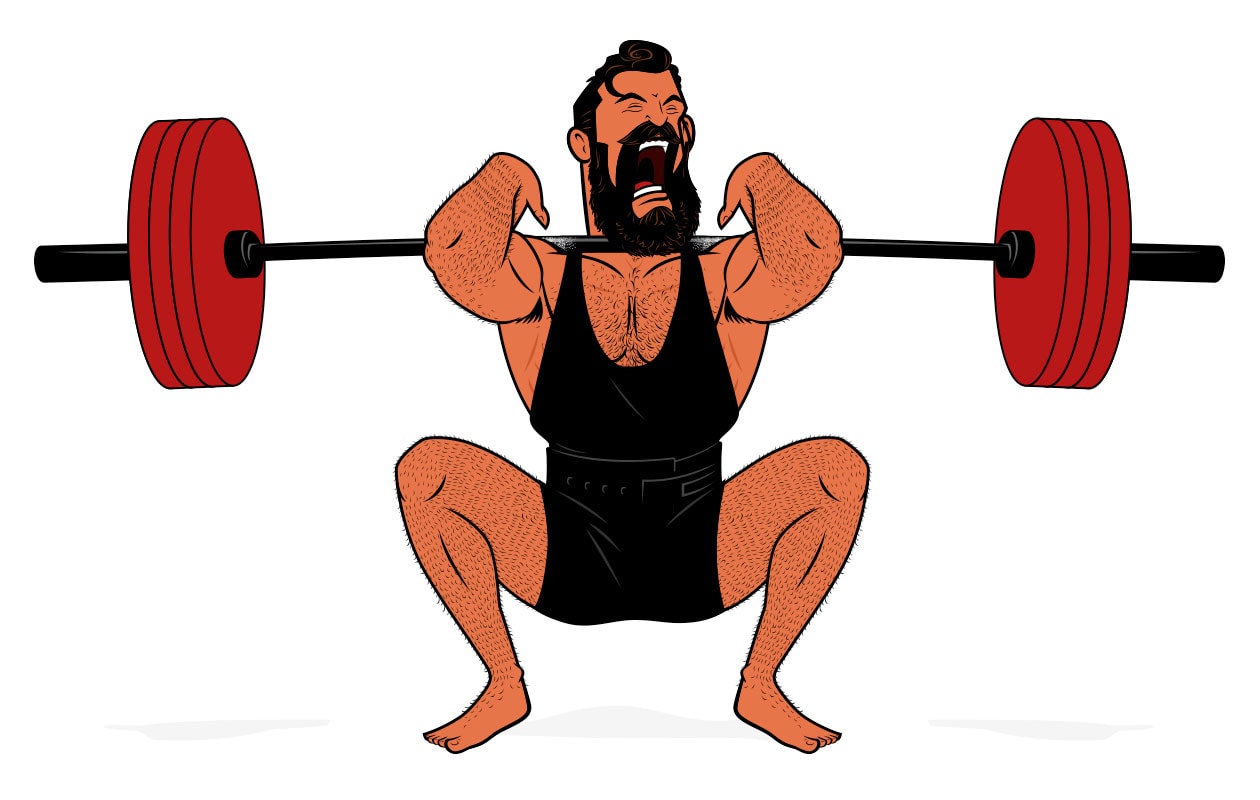
When we do a deep front squat, high-bar squat, leg press, or leg extension, we're working our quads through a full range of motion, and it's the bottom of that range of motion that tends to be the hardest, which is amazing for stimulating muscle growth. Then, because our quads are so massive, it can take quite a while for them to recover. Plus, the big leg exercises tend to be so heavy that they cause quite a lot of overall fatigue. If we're training our legs more often, it can leave less energy for our other lifts. That's why people often find it hard to bulk up their upper bodies when doing programs like StrongLifts 5×5 and, to a lesser extent, Starting Strength.
Now, to be clear, we're talking about building muscle here. If you're training for strength, there are a number of popular programs that recommend squatting every day, and that's fine. But those workouts aren't designed to stimulate muscle growth. When we're working out to build muscle, it tends to be better to train your legs a bit harder and a bit less frequently. Doing 4–8 sets for your legs twice per week will probably be enough to maximize your rate of muscle growth.
How Often Should You Train Your Shoulders?
Our shoulders are a fairly big muscle group, but similar to our backs, most shoulder exercises have a fairly poor strength curve, and so it's hard to stimulate much growth or cause much muscle damage. Many people benefit from training their shoulders as often as 3–4 times per week.
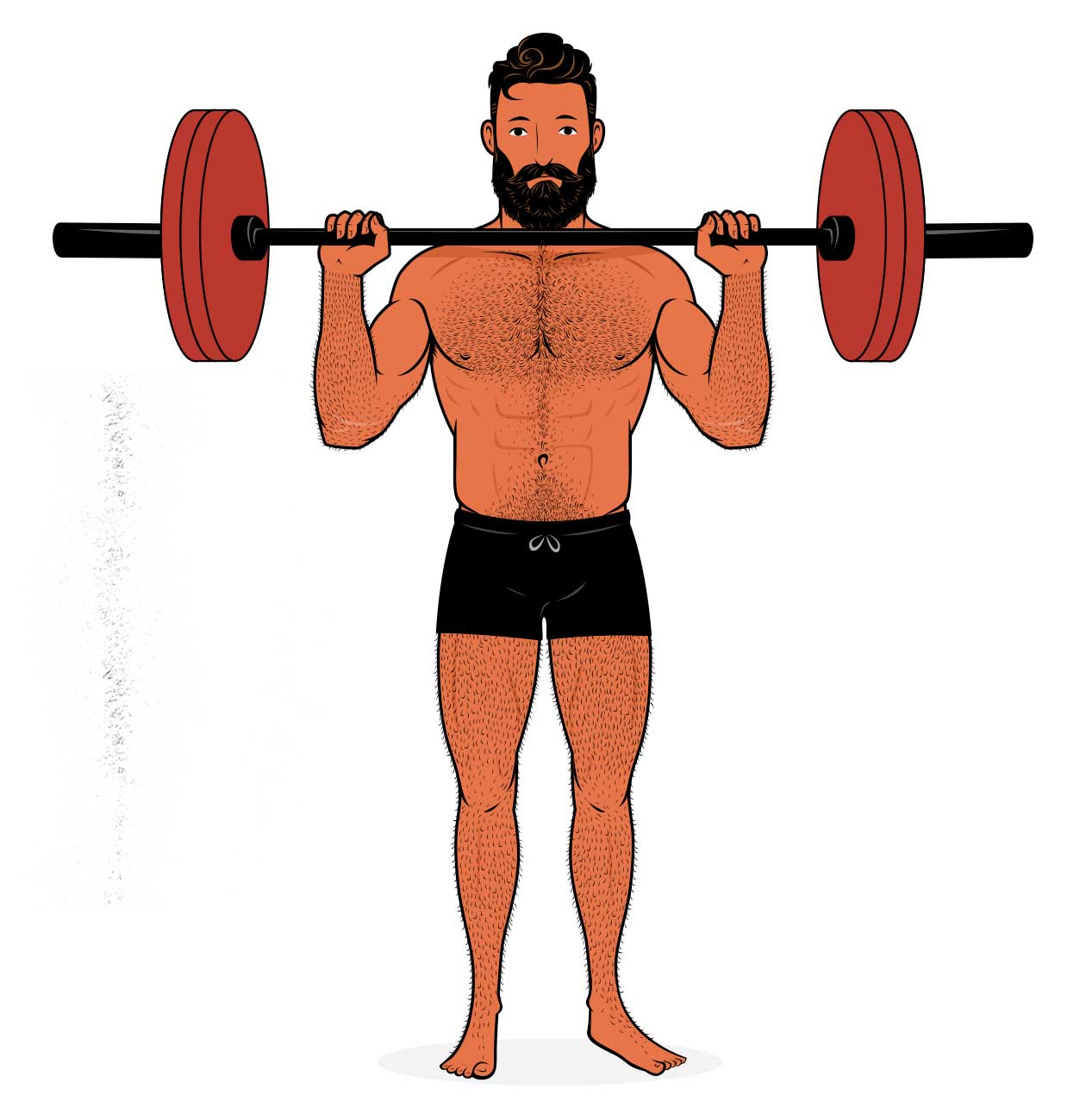
For example, if we look at the most famous shoulder exercise, the overhead press, the strength curve is such that it's hardest when the barbell is at forehead height, where your front delts are already at fairly short muscle lengths. It works them quite hard, and they're certainly the limiting factor, but it's nothing compared to how a bench press works the chest or how a squat works our quads. As a result, our shoulders can often recover fairly quickly. If we train our shoulders with the bench press, close-grip bench press, and incline bench press, we can challenge them at longer muscle lengths, but even then, they often recover quite fast.
Plus, there are different heads of our shoulders, all of which perform different functions. One day you might want to train the overhead press, another the bench press, and another the close-grip bench press. But you'll also want to include some lateral raises or upright rows for your side delts, and plenty of rowing and chin-ups for your rear delts. As a result, you may want to include at least some shoulder work in every single workout you do.
How Often Should You Train Your Arms?
If you train your arms hard, then training them twice per week is probably enough to maximize their rate of muscle growth. But if you're only doing a couple sets of biceps curls or triceps extensions at the ends of your workouts, it can help to train them more often.
The muscles in our arms are fairly small, and it's common for people to train them 3–4 times per week. Mind you, that's because most people don't train their arms with the same rigour as they train the muscles in their torsos. If you choose good arm exercises and you do them early enough in your workout, it's possible to stimulate at least a few days of muscle growth.
For example, this study found that if you do 8 sets of rows, your back will need a couple of days to recover, but your biceps will be fully recovered within 24 hours. But if you do a dedicated arm workout, that changes dramatically. In this study, beginners doing 8 sets of preacher curls caused enough muscle damage that, after 4 days, their biceps were still recovering.
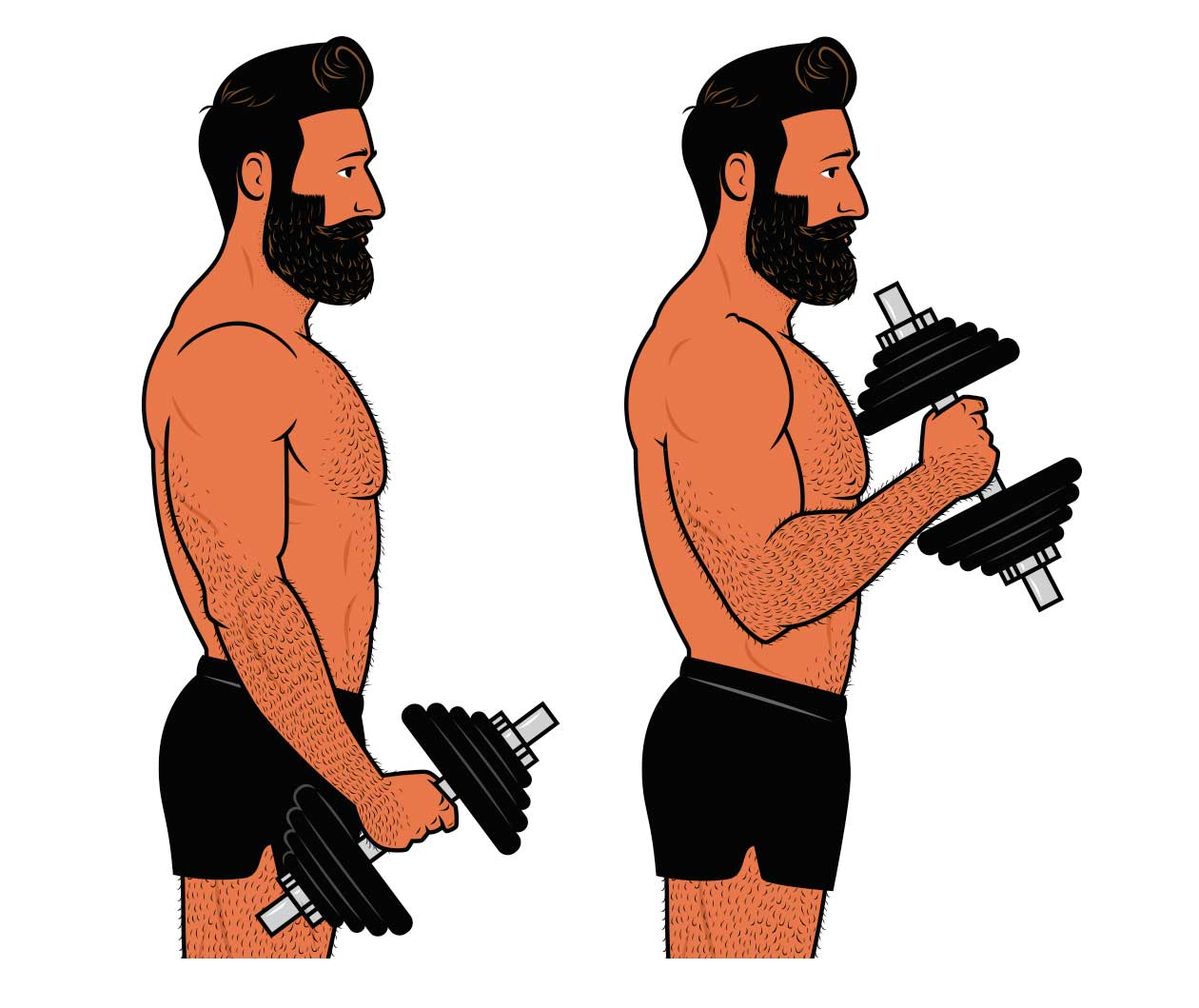
Now, that doesn't mean that we should be annihilating our arms every workout. For example, if you're doing full-body workouts 3 times per week, and if you're doing compound lifts like chin-ups, bench presses, and rows, then you're already doing a halfway decent job of stimulating your biceps, triceps, and forearms 3 times per week, and that's good. Not only does that volume add up, but those workouts are also fairly quick to recover from, allowing you to train your arms more often.
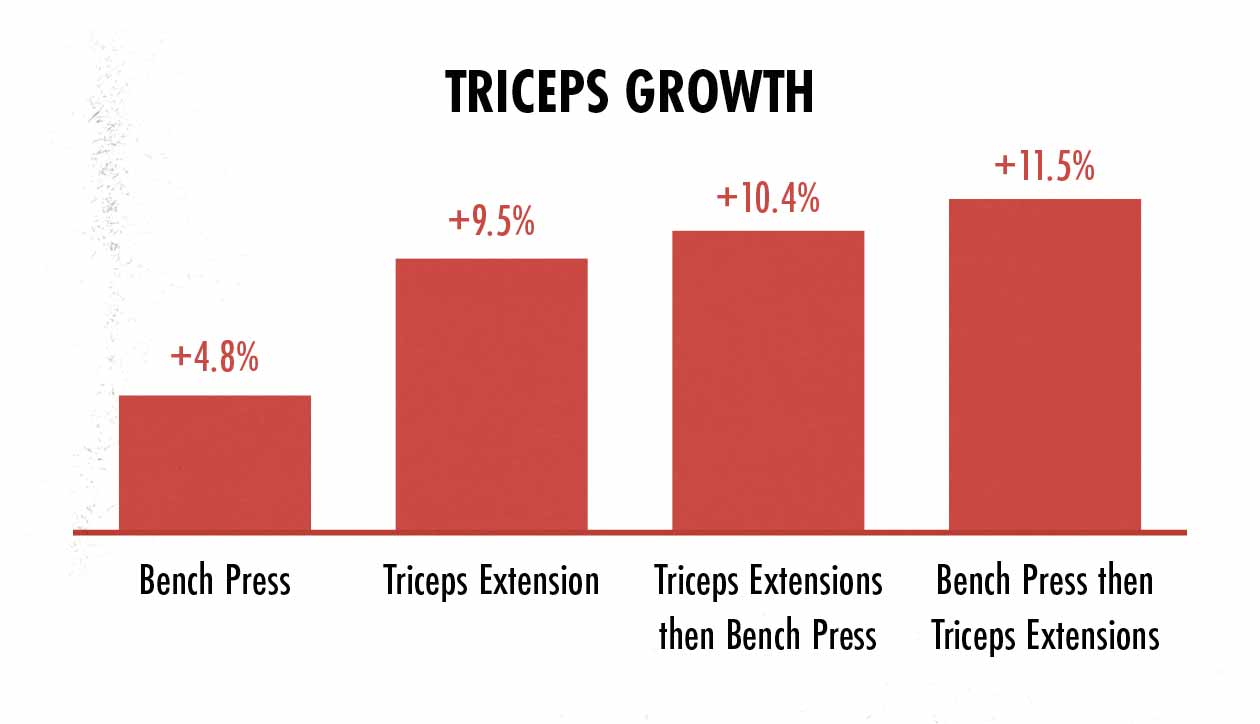
Then, if we look at the research on isolation lifts, it's clear that we can build bigger arms much faster by including direct arm work. For example, in this study, we see twice as much growth in our triceps if we do both the bench press and the triceps extensions. The same is true with many of the other muscles in our arms.
So, after doing your compound lifts, you could add in some biceps curls, triceps extensions, lateral raises, and forearm curls. Or you could add a fourth workout day, giving your arms a day all to themselves. Just keep in mind that if you do a dedicated arm day, your arms may need a few days to recover before you'll benefit from doing another arm workout.
How Often Should You Train Your Abs?
Our abs recover quite quickly and can handle quite a lot of training volume, meaning that we can train them a few times per week without any issues. And since our abs are active during most of our lifts, we often train them every workout—even if we never do any ab isolation exercises.
Like your arms, your abs will get a little bit of work during most of your workouts. The chin-up, push-up, overhead press, front squat, and a variety of other lifts all train your abs. As a result, it's common for people to build big abs simply by doing the big compound lifts. But if you notice your abs falling behind, doing some crunches or hanging leg raises at the end of your workouts can work wonders.
How Many Days Per Week Should You Work Out?
Okay, now that we've talked about how often you should train your muscles, let's talk about how to organize that into different workout routines. For example, if you want to train your muscles 3 times per week, there's more than one way to do that:
- 3 full-body workouts, training every muscle every workout.
- 6 workouts, 3 for your upper body, 3 for your lower body.
In both cases, we're training our muscles at least twice per week, and so both workout routines can be similarly effective, depending on how we program them.
Working out 3–6 times per week tends to be ideal for building muscle. Anywhere in that range can be ideal, meaning that working out 6 days per week isn't necessarily any better than 3 days. It all depends on what kind of workout split you're using.
2-Day Full-Body Workout Routines
To build muscle at full speed, we want to train each muscle at least twice per week. If we're only working out twice per week, that means we need to train every muscle every workout. That means doing 2 full-body workouts. The good news is that there's research, such as this study, showing that people can stimulate a good 3 days of muscle growth with a full-body workout. And there's also research, like this study, showing that training our muscles twice per week causes just as much muscle growth as training them 3 times per week.
Why would you do 2 full-body workouts per week? If you're extremely busy, building muscle is a lower priority in your life, you're trying to make room for other forms of exercise, or if you're cutting, then it can make sense to scale back your weight training, and that's where doing full-body workouts can come in handy. You can work out just twice per week and still get pretty good results. Plus, lifting twice per week is enough to get most of the health benefits of weight training.
What are the downsides? The problem with working out just twice per week is that it's easy for the workouts to become long and draining, especially if you're trying to do everything at once. Most of your energy will be eaten up by squatting, bench pressing, deadlifting, overhead pressing, and doing chin-ups. And that's fine. But it doesn't leave much room for, say, biceps curls, neck extensions, and hanging leg raises.
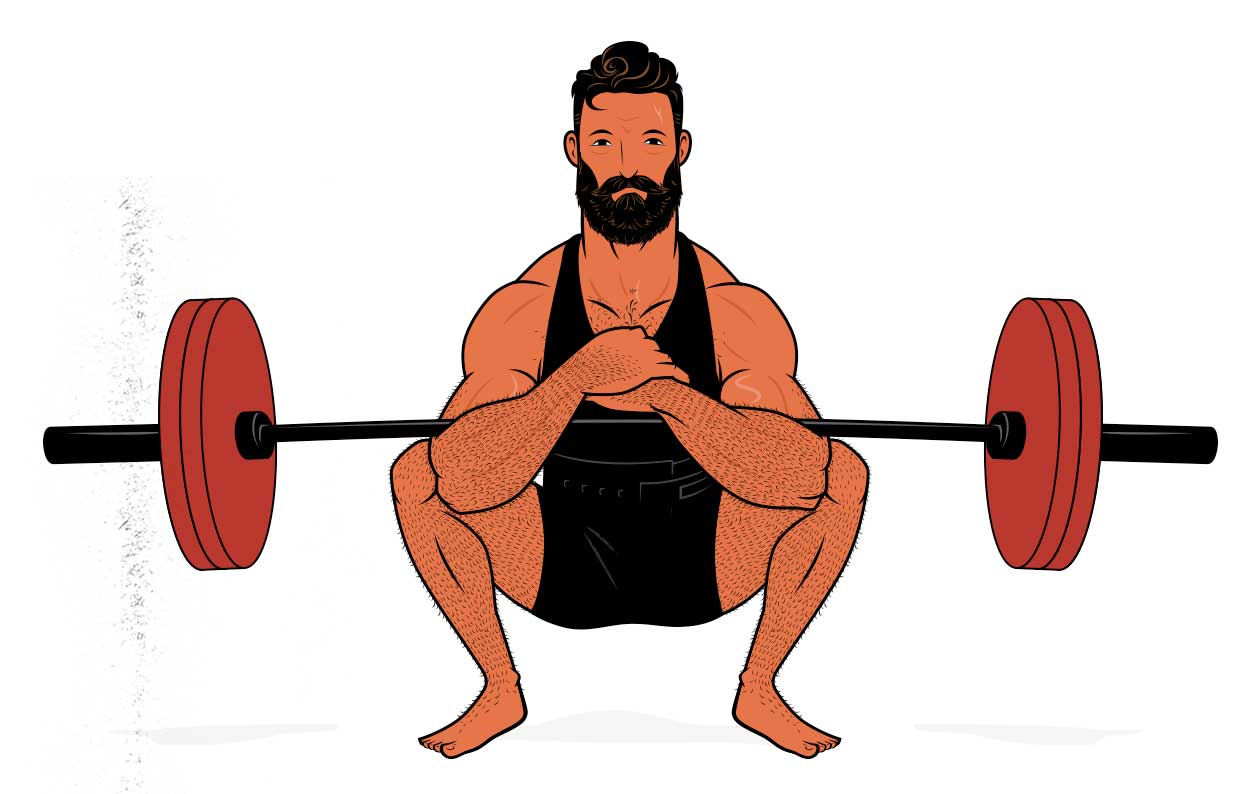
To build a 2-day workout program, we recommend making 2–3 different full-body workouts and alternating between them. For example, the first workout might have 3–4 sets of front squats, the second might have no squats, and the third might have 2–3 sets of Zercher squats. That gives you a squat frequency of 1.5 times per week, and one of the squat workouts is fairly easy. That frees up time and energy for mixing in a wider variety of lifts, allowing you to make your program more balanced, and allowing you to keep each workout from becoming overly fatiguing.
3-Day Full-Body Workout Routines
If we're working out 3 days per week, that gives us a bit more wiggle room. We only need to train our muscles twice per week, so not every workout needs to train every muscle. That makes things much easier. For instance, we can squat and bench twice per week, but train our shoulders and arms three times per week.
The research on full-body workout routines is quite good, too. For example, in this study, putting a rest day between the full-body workouts allowed the participants to fully regain their strength, allowing them to train hard again. This is important because it means that even just that single day of rest is long enough to allow us to outlift ourselves every workout, achieving progressive overload.
Why would you do 3 full-body workouts per week? If you're a beginner, doing 3 full-body workouts per week will work all of your muscles often enough for you to build muscle as fast as possible, and having a day (or two) of rest between your workouts will give your body a chance to recover. Your hands will get a break, so will your traps, so will your back, and so will your connective tissues.
Even as an intermediate lifter, doing 3 full-body workouts is often enough to allow you to build muscle at full speed overall. But you might have some areas that you can't invest a lot of energy into. That can mean doing specialization phases, where you spend a few months focusing on just a few muscle groups. That way you can bring up your arms, or your neck, or improve your bench press, or whatever it is you're eager to do. And that works very well, too.

Personally, I've gained 65 pounds by doing 3 full-body workouts per week. Then, when life gets busy, I'll often train just twice a week. That's also allowed me to maintain a low body-fat percentage. And I've brought my bench press one-rep max up to 315 pounds. I know there are advantages to training more often, and we'll cover those in a moment, but there's no need to think that you have to train more often to continue getting bigger and stronger.
What are the downsides? If you're an intermediate lifter, you could make an argument that doing more workouts per weeks gives you more time to train a wider variety of muscles—your neck, forearms, calves, and so on—without needing to give up on the essentials: squats, deadlifts, bench presses, overhead presses, chin-ups, biceps curls, and triceps extensions. There are so many great exercises for building muscle, and we only have so much time to do them. By adding more workouts, we give ourselves more time and energy to do more lifts.

To build a 3-day workout program, as with the 2-day workout routine, we recommend making 2–3 different full-body workouts and alternating between them. For example, the first workout might have 3–5 sets of the bench press, the second might have the overhead press, and the third might have a close-grip bench press. That gives you a bench press frequency of twice per week, your chest has enough time to fully recover between sessions, and you're training your shoulders 3 times per week, which suits them well. (This is the approach we used in the 3-day Outlift workout routine.)
4-Day Split Workout Routines
If you're working out 4 days per week, that gives us a lot of great options. You only need to train your muscles twice per week, so now we can explore body-part splits, perhaps even using a combination of full-body workouts and body-part splits.
However, it's worth noting that when compared against full-body workouts, 4-day workout routines don't necessarily stimulate more muscle growth overall. For example, in this study, the participants doing a 4-day routine increased their chest circumference by slightly more, but overall, gained the same amount of muscle mass as the group doing 3 full-body workouts per week. So there may be a slight advantage to training more often if it allows you to work some muscles harder, but it doesn't appear to be very large.
Why would you do 4 workouts per week? As you get stronger, your sets will become more draining, requiring longer rest times. On the bigger lifts, it's common for 2-minute rest periods to become 3 minutes, then 4 minutes, and then 5. Workouts can start to get long, and it can be hard to grind through exercise after exercise. That's when it starts to make sense to either, a) do specialization phases, or b) add an extra workout day.
What are the downsides? There are no major downsides to training 4 days per week, other than the extra time investment, especially if you need to commute to a gym. Our connective tissues still get plenty of rest, and most people can recover from them fairly well. So if you want to add an extra workout day, I say go for it.
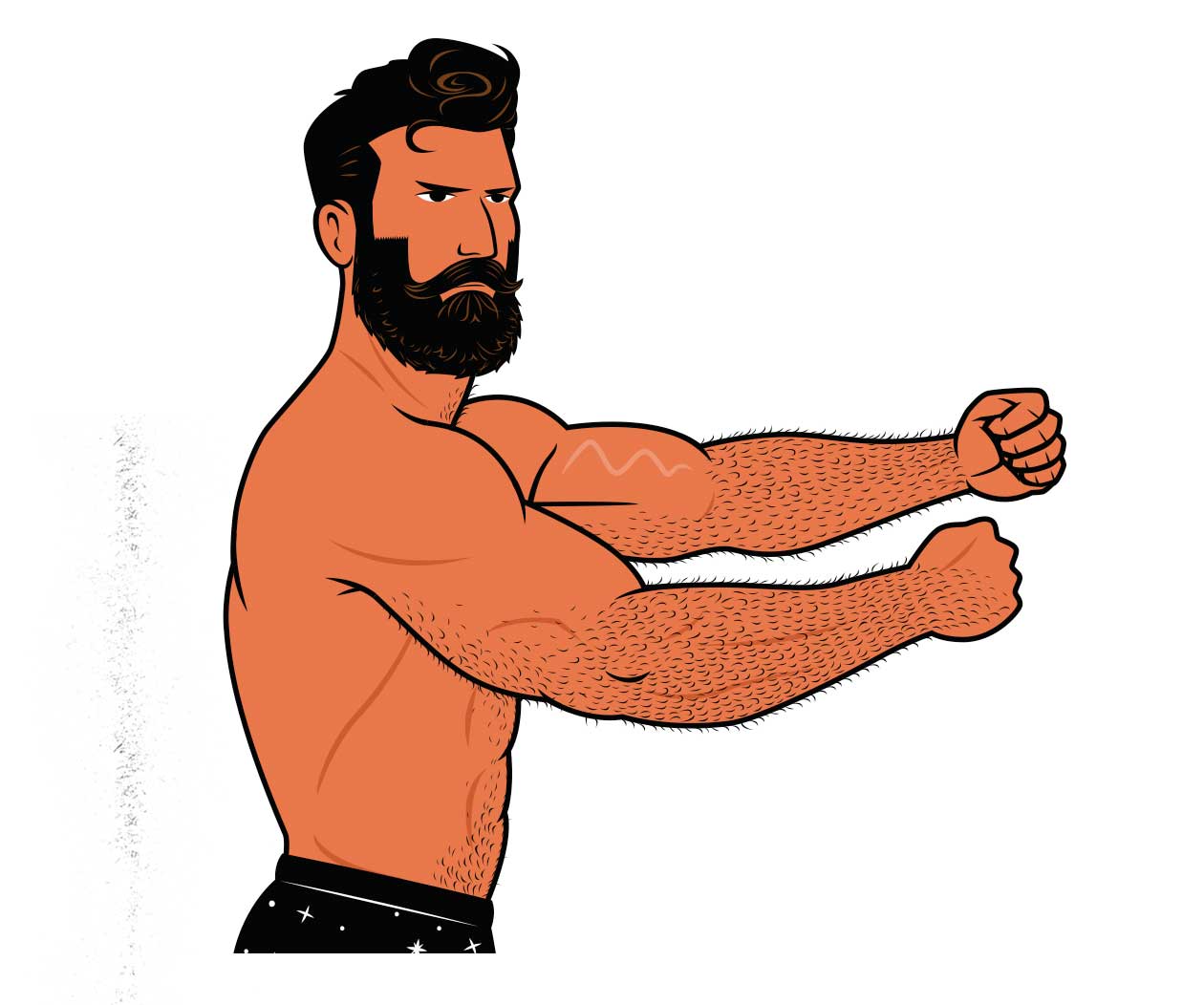
To build a 4-day workout program, there are a variety of different options, and many of them are good. Here are a few great ones:
- 3 full-body workouts + an arm day: if you're enjoying doing 3 full-body workouts per week but you want some extra arm work, these are great. You can do full-body workouts on Monday, Wednesday, and Friday, then blast your arms on Saturday.
- An upper/lower split routine: a common way for athletes to bulk up is to alternate between upper-body and lower-body workouts. Monday you start with the bench press and row; Tuesday you start with the squat and Romanian deadlift; Thursday you start with the chin-up and overhead press; and Friday you start with the deadlift and leg press. Marco loves these, and has had great success using them.
- 2 full-body workouts + an upper/lower split: my personal favourite way to train 4 days per week is to do a full-body workout on Monday and Wednesday, a lower-body workout on Friday, and then an upper-body workout on Saturday. It gives every muscle at least a day of rest, and it does a better job of spacing out the big compound lifts, keeping each workout fairly easy. (This is how we built the 4-day Outlift workout routine.)
5-Day Workout Routines
If you're working out 5 days per week, you'll either be doing high-frequency training or using a body-part split. Both of those approaches can work quite well, but they aren't necessarily better than training 3–4 days per week.
Why would you do 5 workouts per week? As you get stronger, longer workouts can become hard. By working out more days per week, you can spread the exercises out over more days, keeping your workouts short. A lot of people find those shorter workouts easier to manage, especially if they enjoy going to the gym or enjoy training at home. It becomes part of their daily routine.
What are the downsides? When you're lifting weights 5 days per week, that means doing a lot of back-to-back workouts. Even if you use an elaborate body-part split that keeps you from training your muscles two days in a row, you still need to watch out for fatigue, especially in the areas being worked every day, such as your spinal erectors.
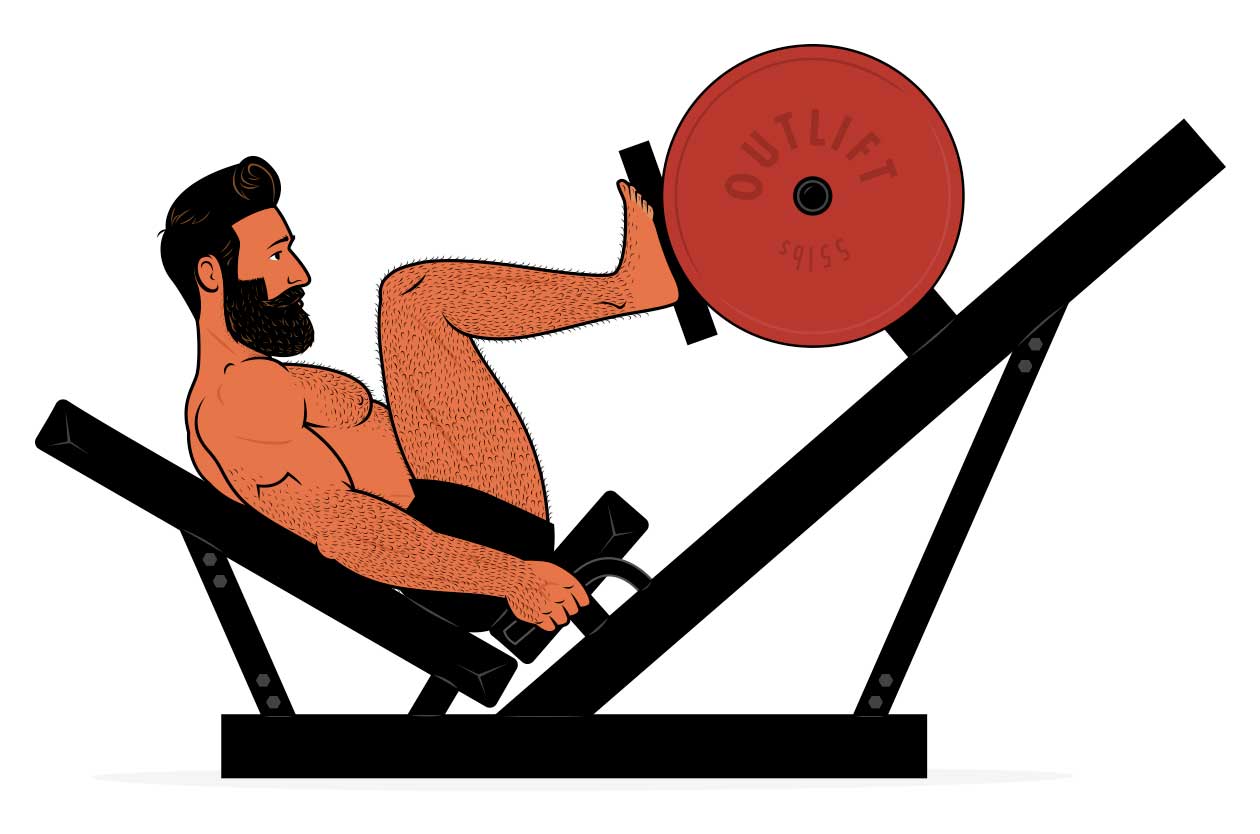
To build a 5-day workout program, you could do short full-body workouts every day, cycling through a variety of different exercises for each muscle group. For instance, Monday is the squat, Tuesday is the leg extension, Thursday is the leg press, and so on. That way you aren't repeatedly hammering your joints with the exact same type of stress.
A more popular approach is to use a body-part split routine. For example, you might use a workout routine like this:
- Monday: bench press + chest-supported rows and accessories.
- Tuesday: front squat + Romanian deadlifts and accessories.
- Wednesday: overhead press + push-ups and accessories
- Thursday: chin-up + dips and accessories
- Friday: deadlifts and margaritas.
That way every muscle has a day of rest between workouts, and we're also managing how often we're doing lifts that tax our lower back. But there are many different body-part split permutations, and many of them are good.
6-Day Split Workout Routines
If you're working out 6 days per week, you'll probably be using a body-part split. It can work well, but again, it isn't necessarily better than training 3–5 times per week.
Why would you do 6 workouts per week? Some people don't like doing long gruelling workouts, and so they enjoy spreading the workload out over as many days as possible, and that's great. Other people enjoy going to the gym or find it easy to dip into short home workouts. If you want to lift weights more often, this is a good way to do it.
What are the downsides? When you're lifting 6 days per week, that means lifting 6 days in a row, and without ever taking getting 2 days of rest in a row. That's a lot, and so it becomes important to manage fatigue. The workouts tend to be short, and you may need to intentionally use smaller lifts to avoid fatiguing your stabilizer muscles: seated shoulder pressing instead of standing, exercise machines instead of free weights, t-bar rows instead of barbell rows, and so on. That's not a problem, but it can make your training less efficient.
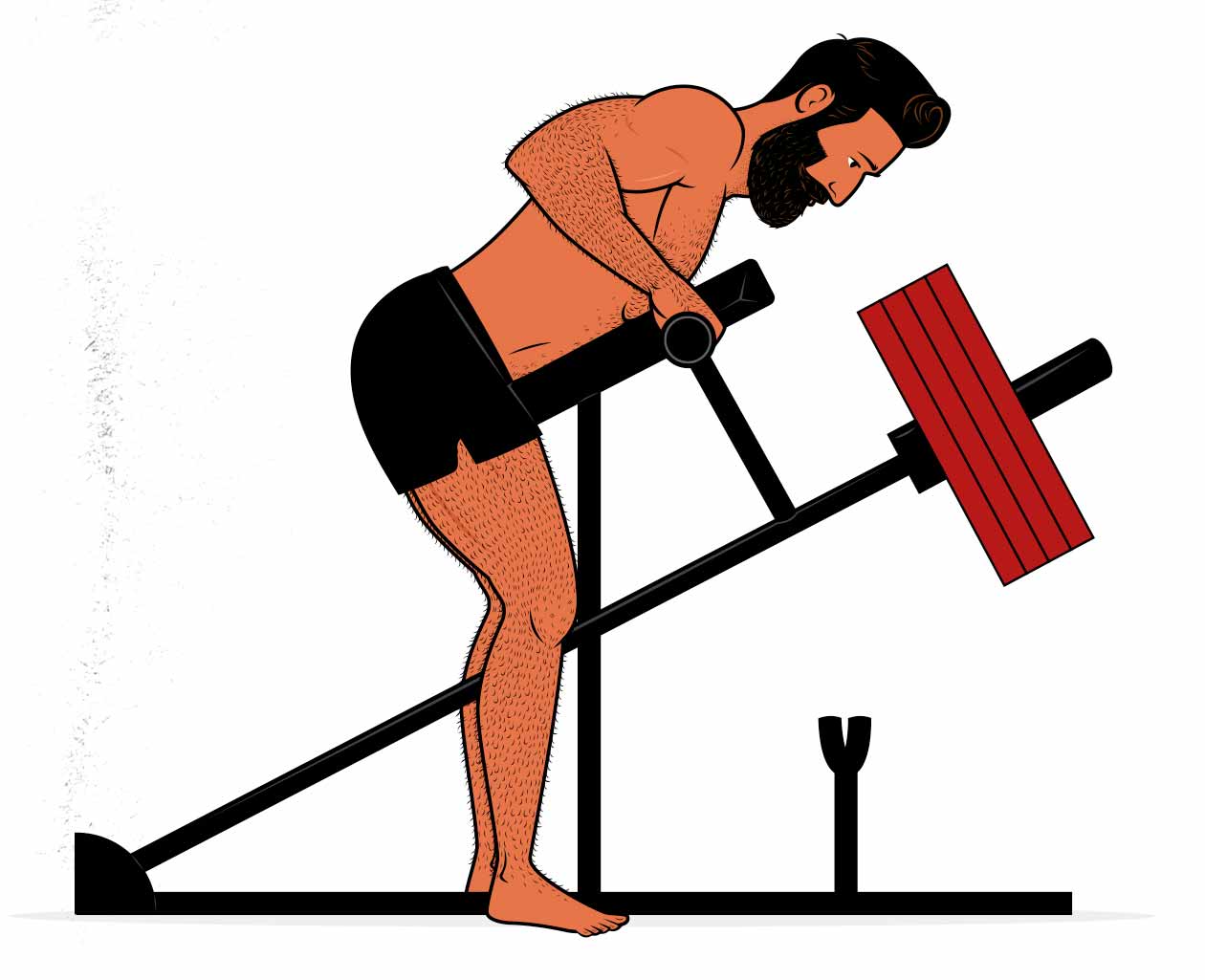
To build a 6-day workout program, most people use a body-part split similar to the ones we've already covered, just with a greater frequency. For instance, doing a push/pull/legs routine twice per week, or doing an upper/lower split 3 times per week. And that works great, giving each muscle a day or two of recovery between workouts. The trick is to choose exercises that don't cause too much fatigue in your stabilizer muscles, such as chest-supported or seal rows instead of barbell rows.
Or, if you want to be exercising 6 days per week but your heart isn't set on lifting, you may really enjoy adding some cardio into your routine. After all, you don't need 6 days of weight training to maximize your muscle growth, and adding some cardio in could be a real boon for your health and fitness. Even just lifting weights is great, and lifting does improve our cardiovascular fitness, but some dedicated cardio can help.
Doing Both Cardio & Weight Training
I won't go too deep into this here, given that we have a full article on combining weight training with cardio, but if you're lifting weights more than 3 days per week, it's something to consider. If the reason you're working out more often is to improve your health, it may be best to combine different types of exercise to get a wider variety of benefits.
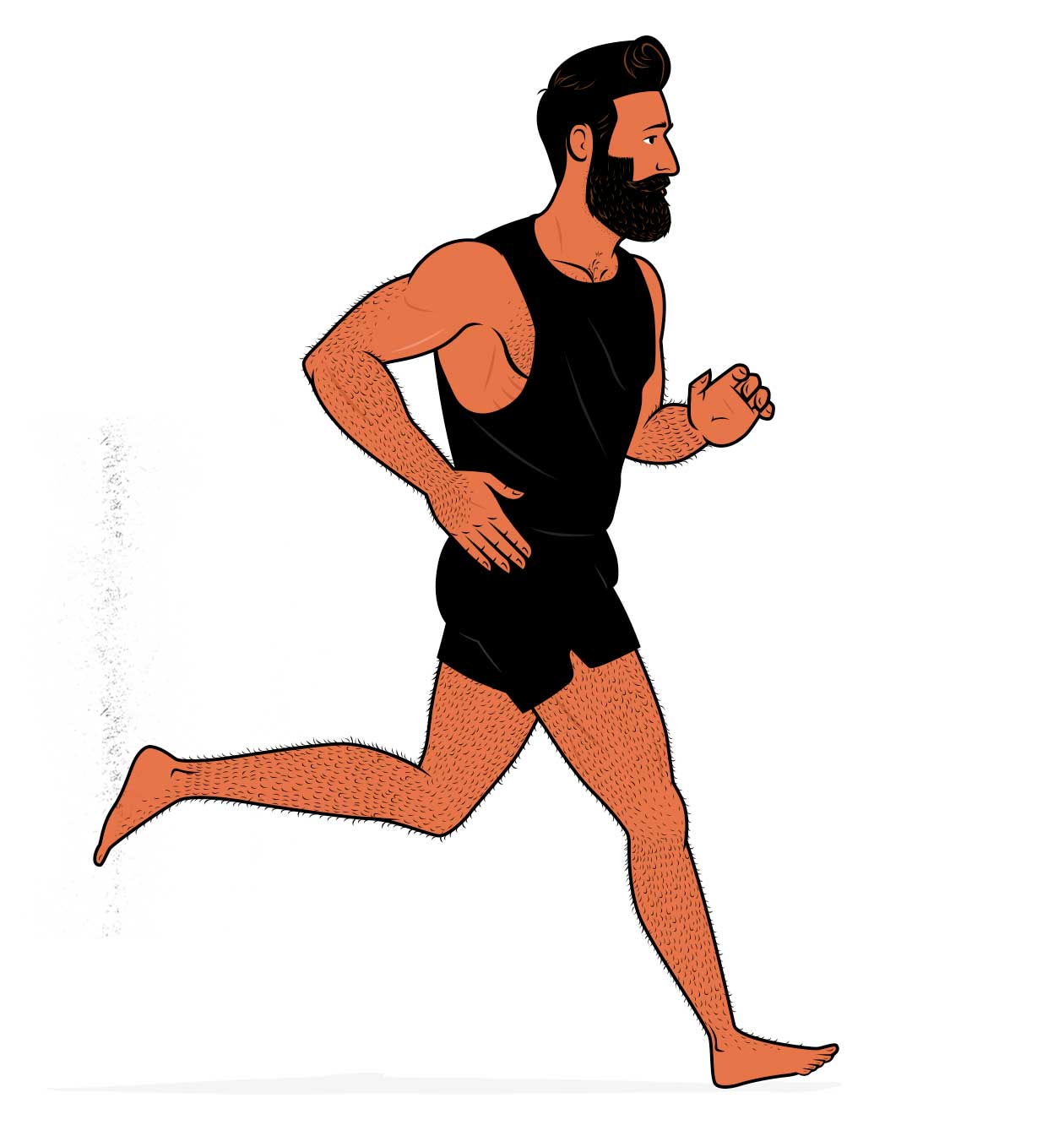
For a quick example, if you wanted to train 5 days per week, there's always the option to do something like this:
- Monday: full-body workout.
- Tuesday: a long, brisk walk outside.
- Wednesday: full-body workout
- Thursday: stationary biking for 30–60 minutes
- Friday: full-body workout
Summary
Training your muscles 2–4 times per week is ideal for building muscle. Working out more often than that is fine, but it won't speed up muscle growth, and you'll need to watch out for fatigue and joint aches.
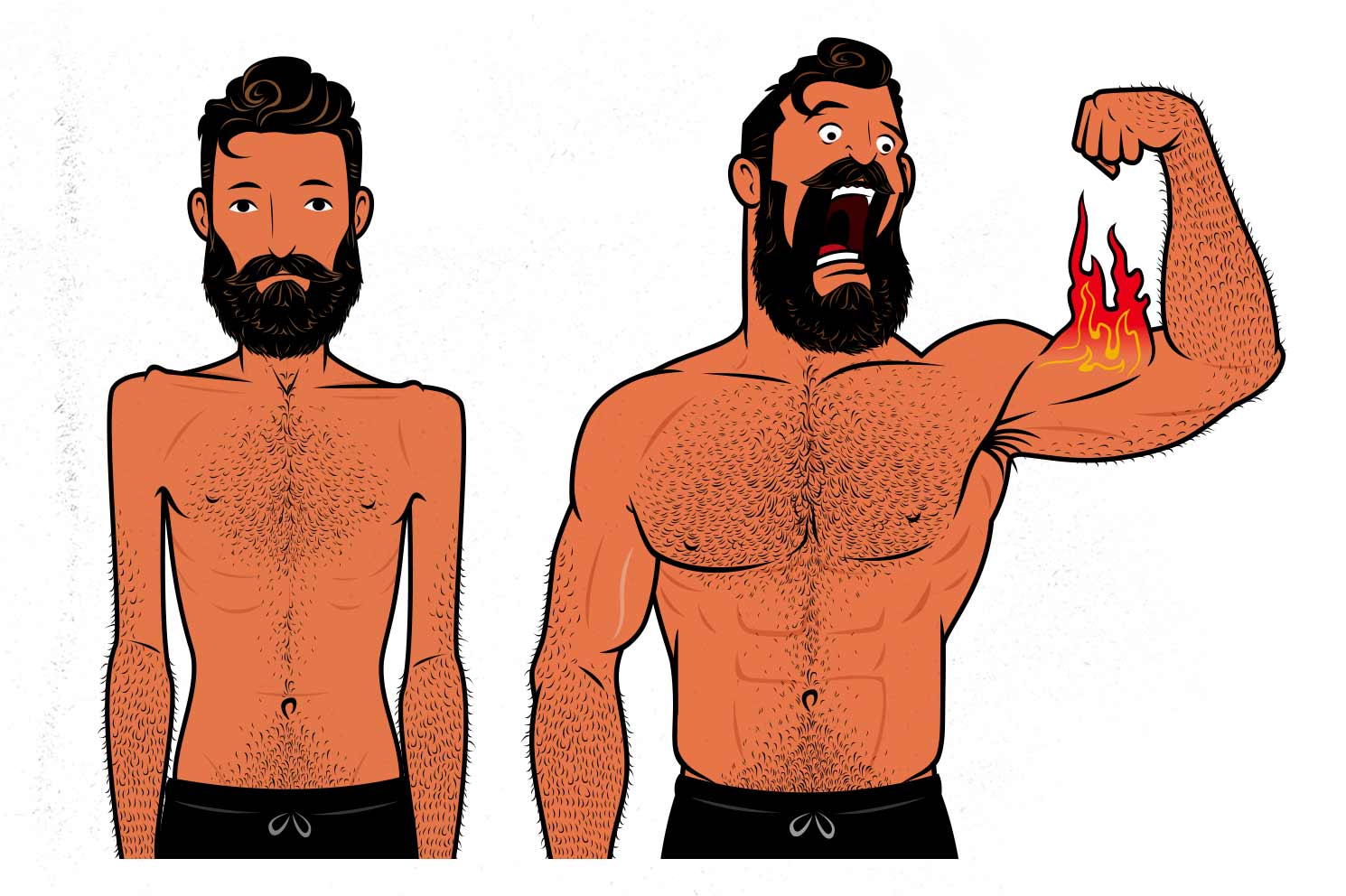
There are many different workout routines that can stimulate your muscles 2–4 times per week, ranging from a 2-day full-body routine all the way up to a 6-day split routine. As a default, we recommend 3-day full-body routines for beginners and early intermediate lifters. Then, once those workouts start getting too long and hard, or if you start running up against a plateau, consider adding a fourth day. But that's just a default. There are a lot of good routines for building muscle.
A good rule of thumb is to make sure that your workouts are strenuous enough to fatigue your target muscles, that you're doing enough repetitions to get a pump, and that you're working them hard enough to cause a day or three of muscle soreness. When that soreness abates, you can train the muscle again.

And, as always, if you want a customizable workout program (and full guide) that builds these principles in, check out ourOutlift Intermediate Bulking Program, which includes both 3-day and 4-day workout routines. We also have ourBony to Beastly (men's) program andBony to Bombshell (women's) program for skinny and skinny-fat beginners, which both use 3-day full-body workout routines. If you liked this article, you'll love the full programs.
Shane Duquette
Shane Duquette is the co-founder and creative lead of Outlift, Bony to Beastly, and Bony to Bombshell, and has a degree in design from York University in Toronto, Canada. He's personally gained 65 pounds at 11% body fat and has ten years of experience helping over 10,000 skinny people bulk up.

Marco Walker-Ng, BHSc, PTS
Marco Walker-Ng is the co-founder and strength coach of Outlift, Bony to Beastly, and Bony to Bombshell, and is a certified trainer (PTS) with a Bachelor's degree in Health Sciences (BHSc) from the University of Ottawa. His specialty is helping people build muscle to improve their strength and general health, with clients including college, professional, and Olympic athletes.
How Much Exercise Per Week to Build Muscle
Source: https://outlift.com/how-often-should-you-work-out/